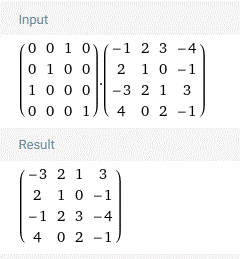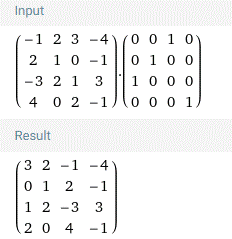
a.
To calculate: The matrix multiplication
The multiplication is
Given Information:
The matrix are,
Formula Used:
The matrix multiplication is possible if and only if order of the first matrix column equal to the order of the second matrix row.
Calculation:
Consider the given matrix,
It can be observed that the number of column of matrix
Now, find the value of
Now, use the graphing calculator to find the product of the matrix.

Hence, the obtained matrix after multiplication is
b.
To calculate: The matrix multiplication
The multiplication is
Given Information:
The matrix are,
Formula Used:
The matrix multiplication is possible if and only if order of the first matrix column equal to the order of the second matrix row.
Calculation:
Consider the given matrix,
It can be observed that the number of column of matrix
Now, find the value of
Now, use the graphing calculator to find the product of the matrix.

Hence, the multiplication of matrix is
Chapter 7 Solutions
PRECALCULUS:GRAPHICAL,...-NASTA ED.
 Calculus: Early TranscendentalsCalculusISBN:9781285741550Author:James StewartPublisher:Cengage Learning
Calculus: Early TranscendentalsCalculusISBN:9781285741550Author:James StewartPublisher:Cengage Learning Thomas' Calculus (14th Edition)CalculusISBN:9780134438986Author:Joel R. Hass, Christopher E. Heil, Maurice D. WeirPublisher:PEARSON
Thomas' Calculus (14th Edition)CalculusISBN:9780134438986Author:Joel R. Hass, Christopher E. Heil, Maurice D. WeirPublisher:PEARSON Calculus: Early Transcendentals (3rd Edition)CalculusISBN:9780134763644Author:William L. Briggs, Lyle Cochran, Bernard Gillett, Eric SchulzPublisher:PEARSON
Calculus: Early Transcendentals (3rd Edition)CalculusISBN:9780134763644Author:William L. Briggs, Lyle Cochran, Bernard Gillett, Eric SchulzPublisher:PEARSON Calculus: Early TranscendentalsCalculusISBN:9781319050740Author:Jon Rogawski, Colin Adams, Robert FranzosaPublisher:W. H. Freeman
Calculus: Early TranscendentalsCalculusISBN:9781319050740Author:Jon Rogawski, Colin Adams, Robert FranzosaPublisher:W. H. Freeman
 Calculus: Early Transcendental FunctionsCalculusISBN:9781337552516Author:Ron Larson, Bruce H. EdwardsPublisher:Cengage Learning
Calculus: Early Transcendental FunctionsCalculusISBN:9781337552516Author:Ron Larson, Bruce H. EdwardsPublisher:Cengage Learning





